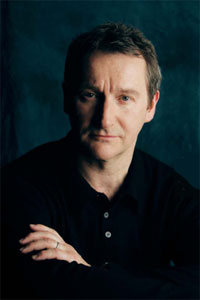David
Bintley

Benois de la Danse nominee
In 1976 he joined Sadler▓s Wells Royal Ballet (now Birmingham Royal Ballet) and quickly proved an outstanding character dancer. Those who were lucky enough to see him dance the leading role in Fokine▓s Petrushka still regard it as this generation▓s def nitive performance.
He was fortunate to have as his artistic director the wise and far-seeing Peter Wright, who from the first encouraged the young Bintley in his wish to choreograph. Bintley made his f rst ballet, to Stravinsky▓s Soldier▓s Tale, before he was 16. His f rst professional work, for his Sadler▓s Wells company, came less than two years later: The Outsider, already dramatic, already showing insight into character.
From 1986 to 1993 he moved from being resident choreographer for Sadler▓s Wells Royal Ballet to being resident choreographer at Covent Garden.
In 1995 Bintley was appointed Artistic Director of Birmingham Royal Ballet. One of his major successes was the full-length Hobson▓s Choice (1989), a broad comedy, which yet tugs at the heartstrings as Ashton▓s La Fille mal gardée manages to do. He can edge into pure dance territory, though his dancers always relate to a theme or a mood, as in Consort Lessons (1983), Galanteries (1986), Allegri diversi (1987) or Tombeaux (1993). He has an uncanny ability to imply rather than to state, so that in Flowers of the Forest (1985) he seems to be saying a great deal about war, about patriotism, even about the fall of Empire. He manages this perfectly in the ever-popular ▒Still Life▓ at the Penguin Café; (1988). He can tell a dramatic story with a sure sense of what works in the theatre, as in his full-length works Swan of Tuonela (1982), The Snow Queen (1986), Cyrano (1991), Far from the Madding Crowd (1996) and his superbly successful full-length ballet Edward II (Stuttgart Ballet, 1995), based on Marlowe▓s play, which has proved even more successful with English audiences that German. His full-length work, Arthur, developed even further his uncanny ability to transform mythology into dance and Cyrano (2007). He can be serious and spiritual, as in his deelpy felt The Protecting Veil (1998).
This delight is vividly dramatic, is about believable people in a real world, and yet breathtakingly caught and held in fascinating dance. In the same vein he surpassed himself with his popular hit, The Nutcracker Sweeties, revolutionising the very traditional Nutcracker, using Duke Ellington▓s jazz version. More recently he has enchanted us afresh with The Shakespeare Suite, his witty exploration of love▓s many guises, with the lyricism and classical perfection of his Les Saisons for The Royal Ballet, his imaginative new interpretation of Beauty and the Beast and his jazz-inspired reinterpretation of the Orpheus legend in The Orpheus Suite.
Gallery
